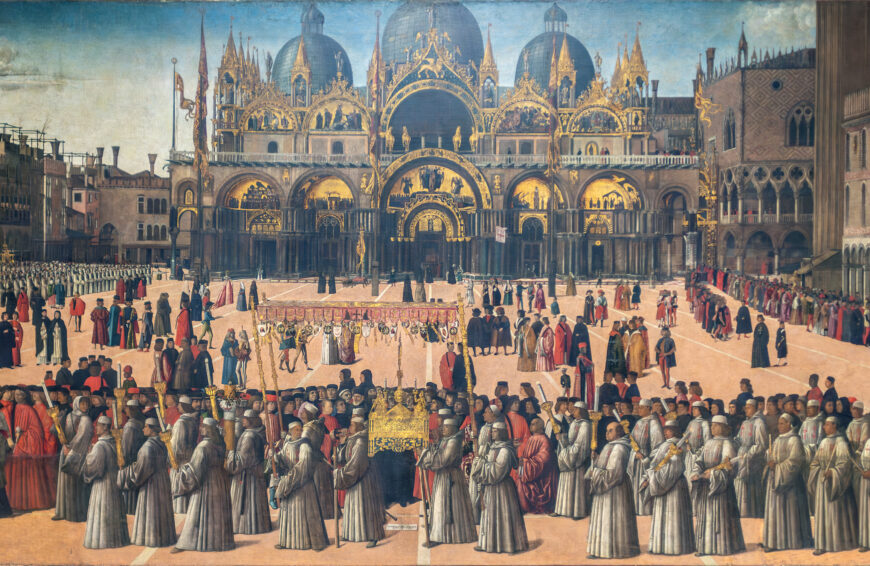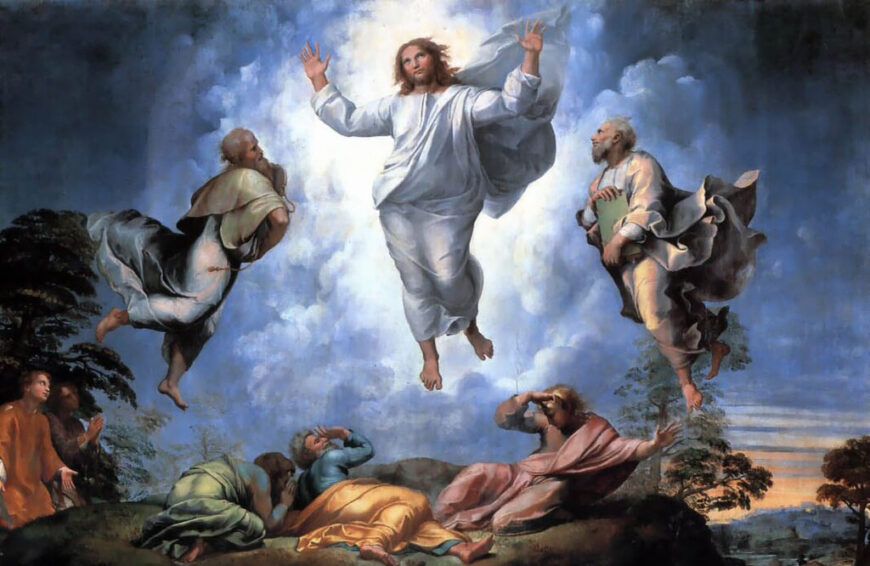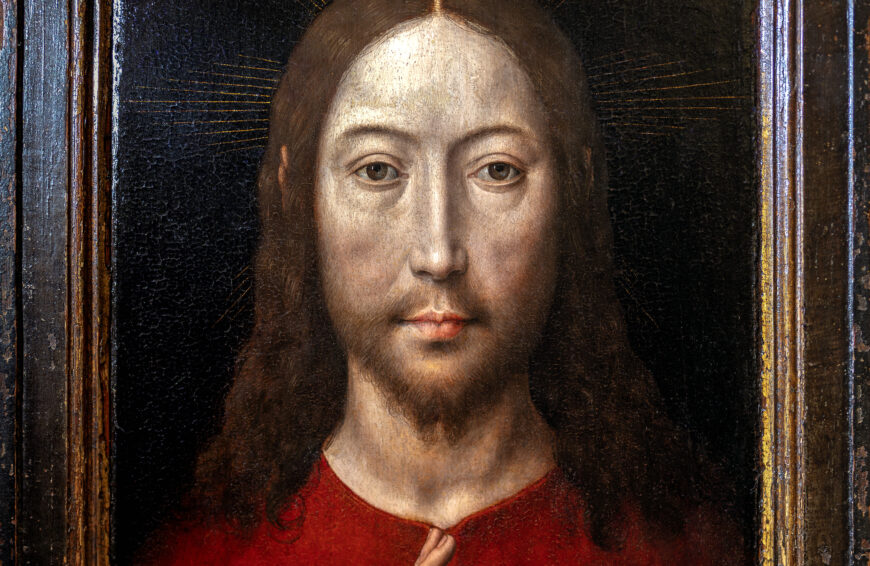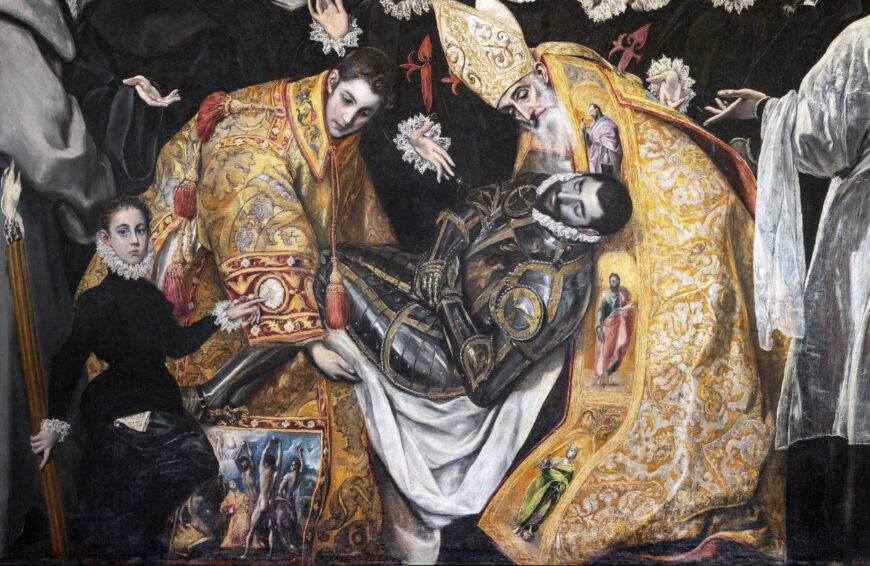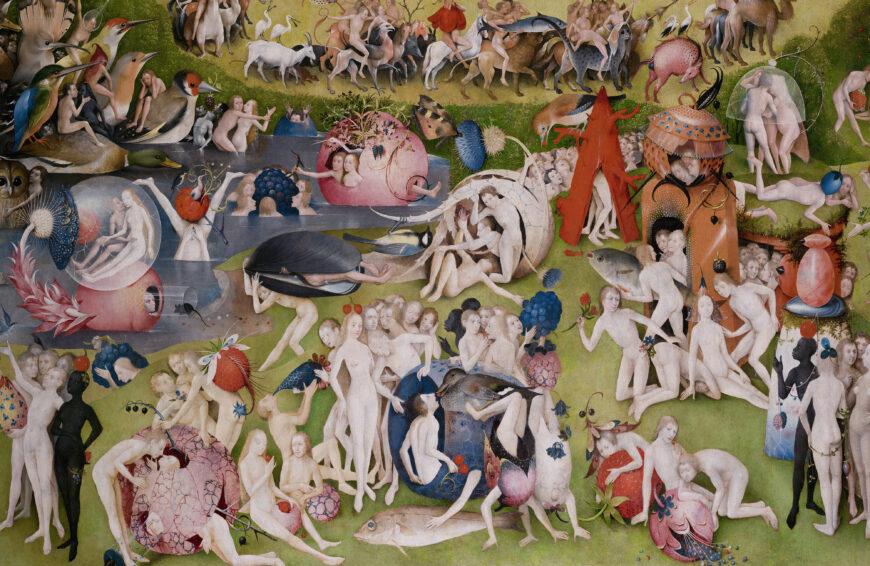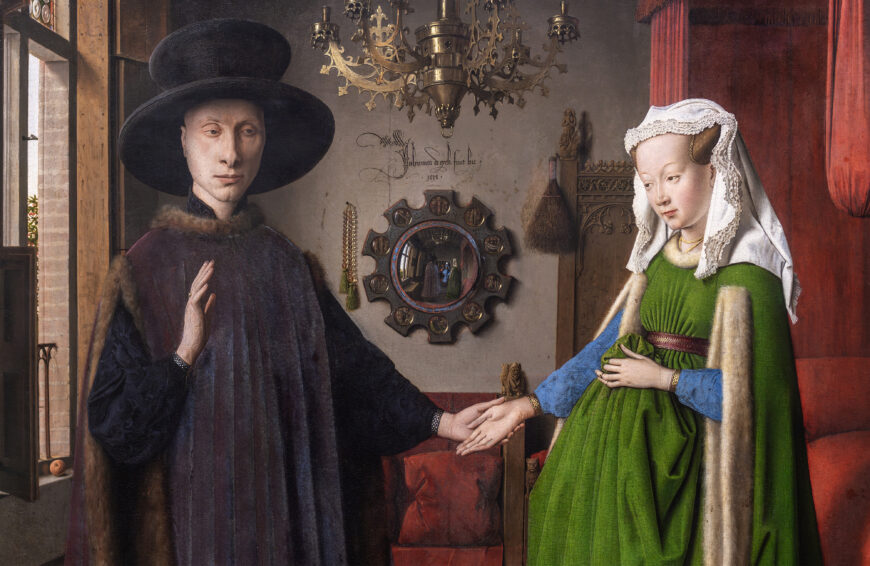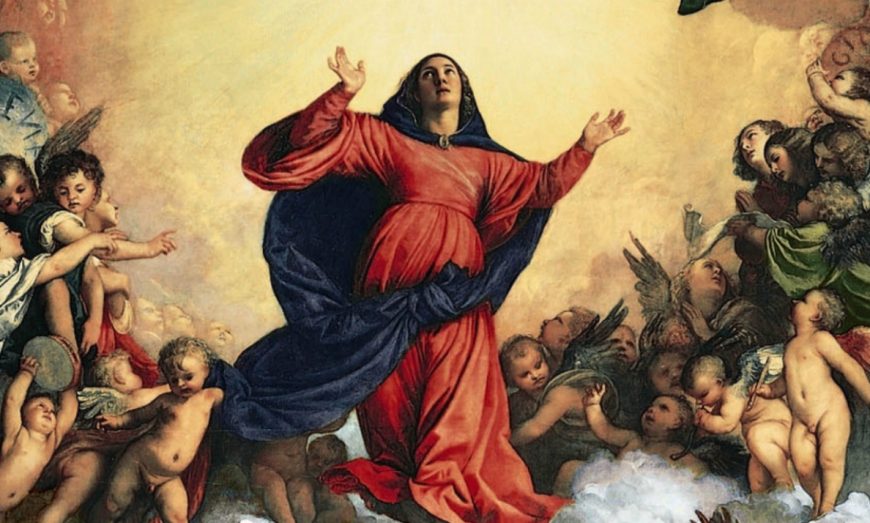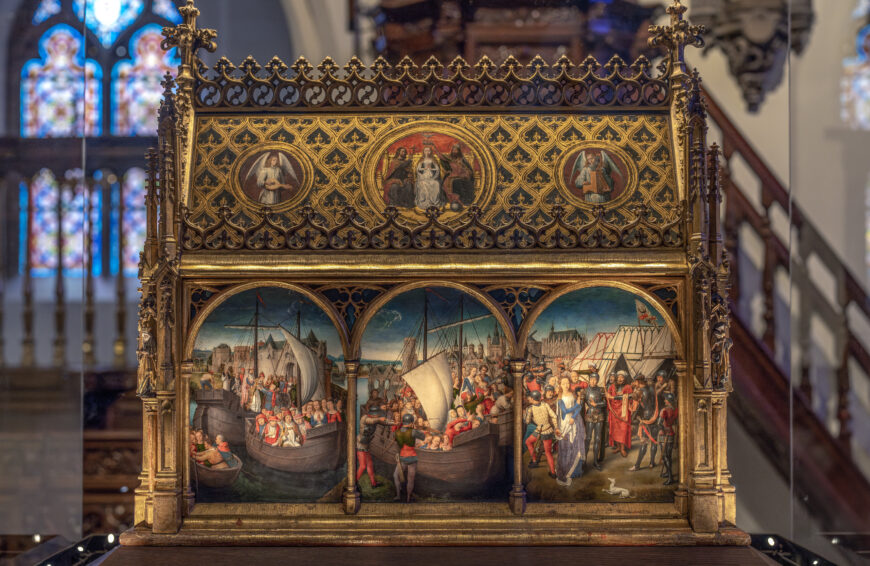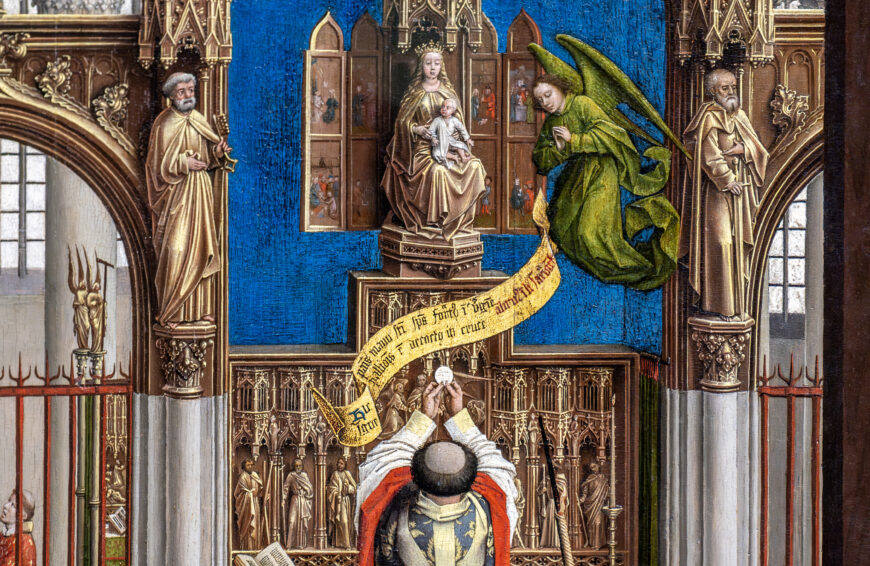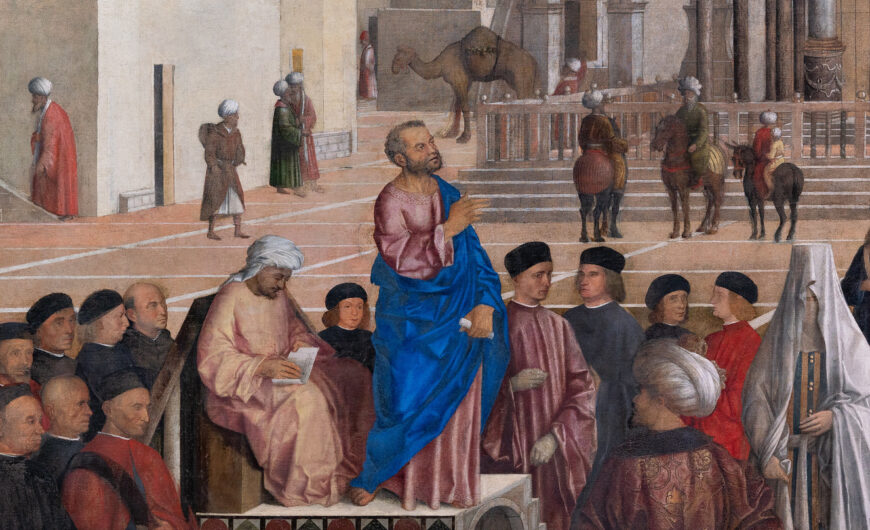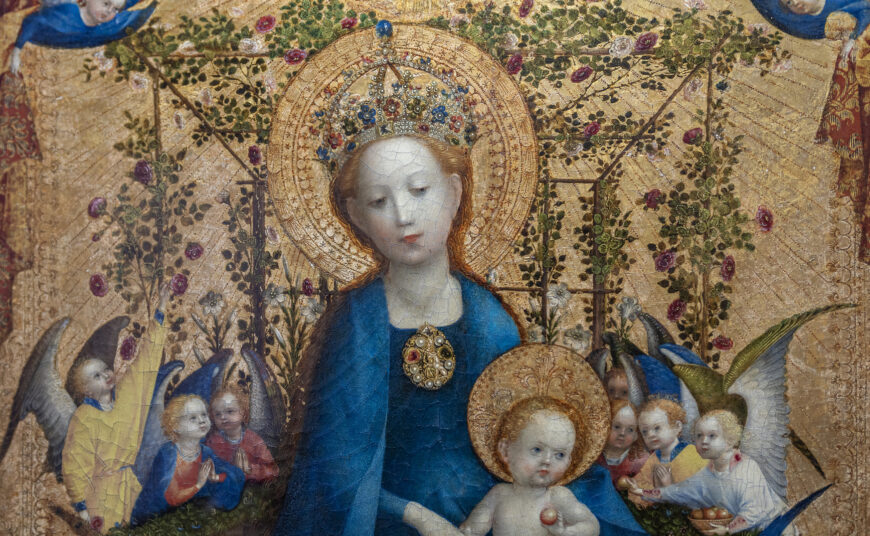This particular artwork perfectly embodies all the things that northern European painters were thought to do best.
Hugo van der Goes, Portinari Altarpiece (or Adoration of the Shepherds with angels and Saint Thomas, Saint Anthony, Saint Margaret, Mary Magdalen and the Portinari family), 1477-78, oil on wood, 274 x 652 cm (Uffizi, Florence). Speakers: Dr. Steven Zucker and Dr. Beth Harris
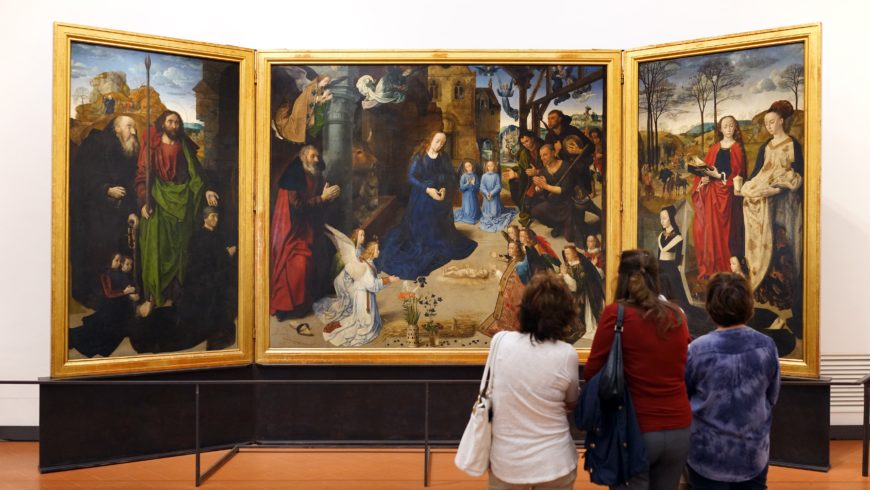
Hugo van der Goes, Portinari Altarpiece, c. 1476, oil on wood, 274 x 652 cm when open (Uffizi) (photo: Dr. Steven Zucker, CC BY-NC-SA 4.0)
Artworks are powerful things. Hugo van der Goes’s Portinari Altarpiece caused quite a stir when it arrived in Florence—the city that was to become its permanent home. Van der Goes, master of light and minute descriptive details, is considered one of the greatest Netherlandish painters of the second half of the fifteenth century. The Portinari Altarpiece is a large triptych that was commissioned by an Italian named Tommaso Portinari, who was living in the Netherlands.
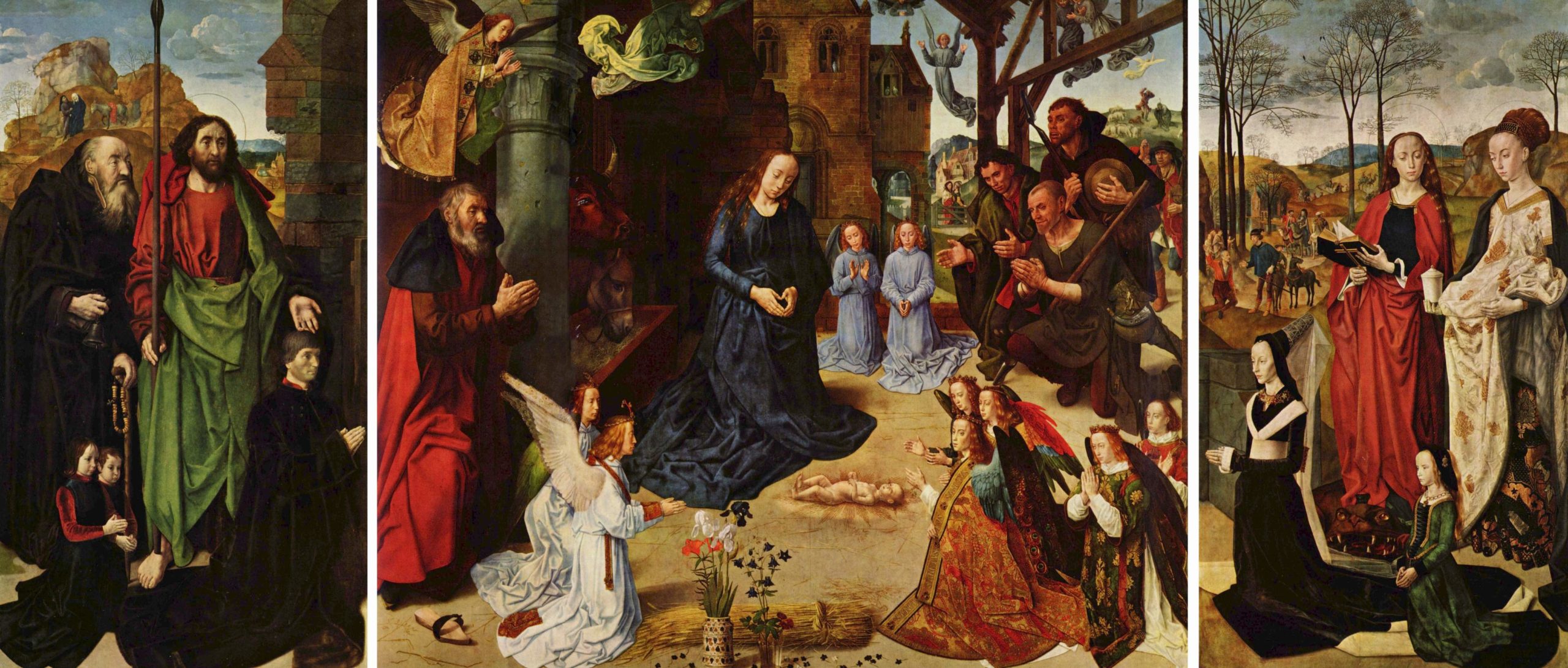
Hugo van der Goes, Portinari Altarpiece, c. 1476, oil on wood, 274 x 652 cm when open (Uffizi)
An Italian family in the North
Just as today, people in the renaissance often traveled extensively or even moved permanently for work. Portinari, his wife Maria Maddalena Baroncelli, and their children were living in Bruges at the time of this painting’s creation. Tommaso worked as a high-ranking agent of the Medici banking industry, helping to run a branch of the bank in Bruges. The Medici were one of the most powerful families in western Europe, and their lineage had developed an extremely wealthy banking, mercantile, and political family. Agents throughout Europe managed branches of their banking empire.
The Portinari family and Florence’s Hospital of Santa Maria Nuova
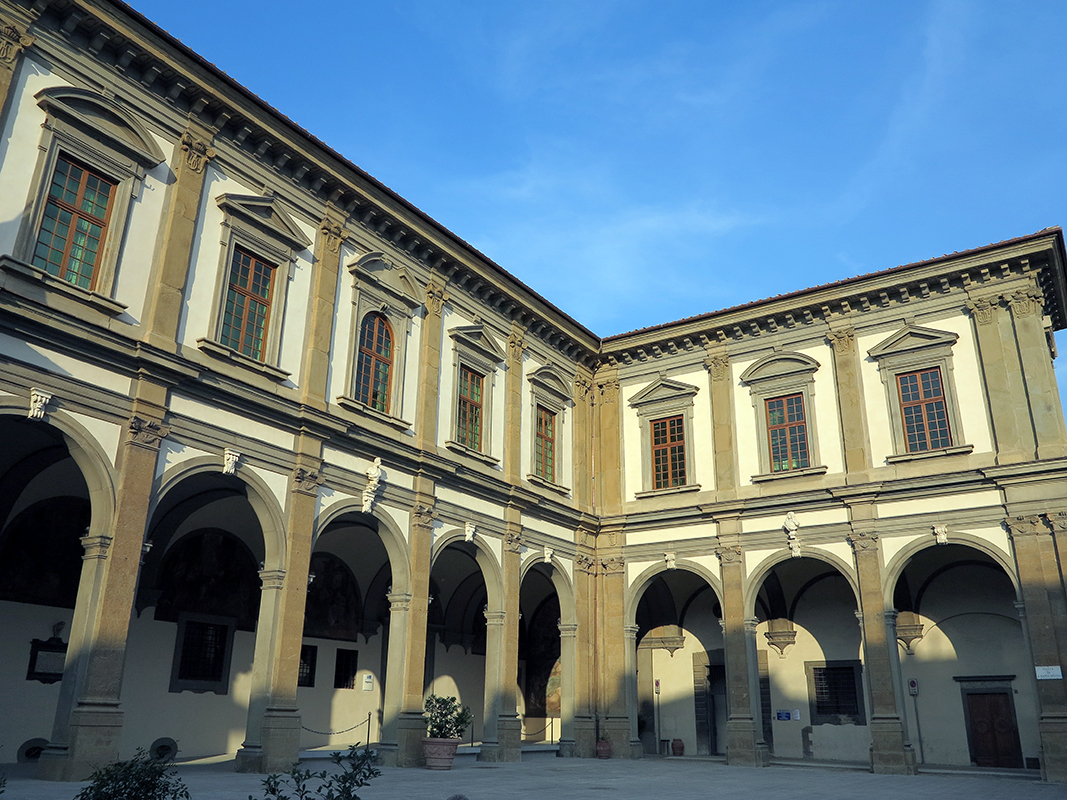
Façade of the Hospital of Santa Maria Nuova (photo: Mongolo1984, CC BY-SA 4.0)
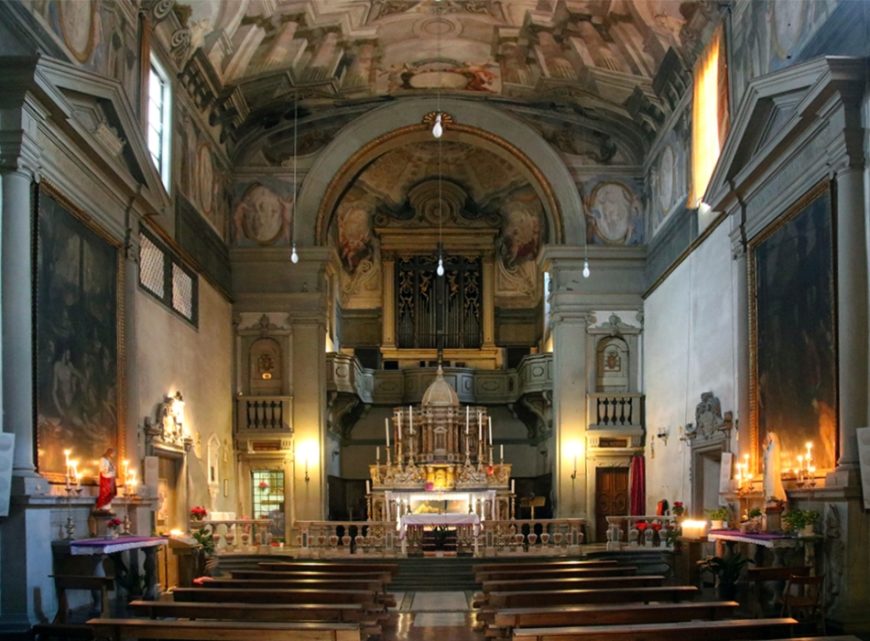
Interior of the church of Sant’Egidio (photo: Mongolo1984, CC BY-SA 4.0)
While Tommaso had made a name for himself in Bruges, his family remained important to the history of Florence. In 1288, Tommaso’s ancestor, Folco Portinari, founded the hospital of Santa Maria Nuova, today the oldest functioning hospital in Florence. In the 1420s, the Portinari family supported further renovations to the hospital, which, by the fifteenth century had around 200 beds (up from 12). As with many hospitals today, Santa Maria Nuova had a connected church, Sant’Egidio.
The Portinari Altarpiece was commissioned for the main altar of this church, and was simultaneously a way for Tommaso to perpetuate his family’s name and importance in conjunction with the city of Florence and the hospital of Santa Maria Nuova.
The Portinari Altarpiece stands as a highlight of Tommaso’s career and the public image he hoped for his family name to retain. Unfortunately, the Portinari family fell on difficult financial times not long after this painting’s creation, as Tommaso lost the Medici family a great deal of money through loans to Charles the Bold, the Duke of Burgundy, which were never paid back in full.
Hugo van der Goes and north-south exchange
Portinari’s choice of a Netherlandish artist to complete this great altarpiece to be sent back to Florence helped to effectively change aspects of Italian art. The latter half of the fifteenth century was characterized by increased artistic exchange between northern European and Italian artists. Italian artists were enthralled by Northern artists’ careful attention to individual details and still-life minutiae incorporated in architectural settings and landscapes. Hugo van der Goes was considered a master of such careful, minute details and his talent was often compared to that of Jan van Eyck, considered one of the greatest painters of the early fifteenth century. Look closely, for example, at van der Goes’s rendering of the foreground angels’ garments. It appears as though we can physically touch the gold brocade of the fabric. And the clear vessel in the foreground also flawlessly seems to capture, reflect, and refract light.

Hugo van der Goes, Portinari Altarpiece, detail of the center panel foreground, c. 1476, oil on wood, 274 x 652 cm when open (Uffizi)
Such tiny details are found throughout the Portinari Altarpiece, and nearly all of them hold some iconographic meaning. When this painting finally arrived in Florence in 1483 for its installation in the church of Sant’Egidio, it had a direct, visible effect on artistic production in Italy. A particularly famous painting that clearly recalls the Portinari Altarpiece is Domenico Ghirlandaio’s Adoration of the Shepherds, painted in 1485—only two years after the Portinari Altarpiece arrived in Florence. In Ghirlandaio’s painting, one can see that the shepherds adoring the Christ child are rendered with such individualized detail that they feel like portraits, as in the Portinari Altarpiece. The group also takes the exact same formation as the three shepherds pictured in van der Goes’s work.
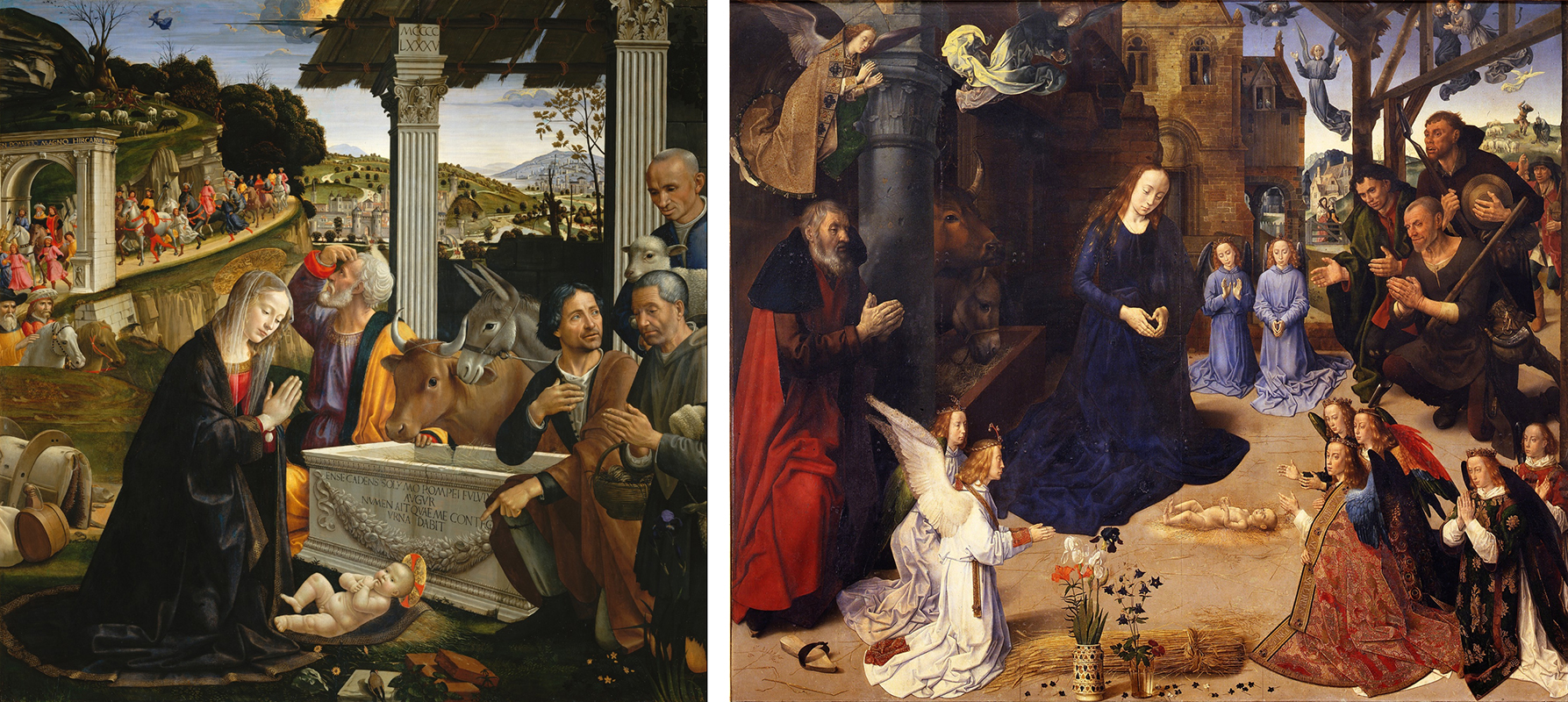
Left: Domenico Ghirlandaio, Nativity and Adoration of the Shepherds, 1485, tempera and oil on panel, 167 x 167 cm (Sassetti Chapel, Santa Trinità, Florence); right, Hugo van der Goes, Portinari Altarpiece, center panel, c. 1476, oil on wood, 274 x 652 cm when open (Uffizi)
Layered iconography
Iconography, commonly used in the field of art history, is the study of the symbolic meaning of things found in works of art. In northern renaissance art, artists frequently used certain figures, objects, and even depictions of biblical or historical events to symbolize something more to period viewers than what was seen on the surface. The iconography throughout the Portinari Altarpiece is extensive and quite complex.
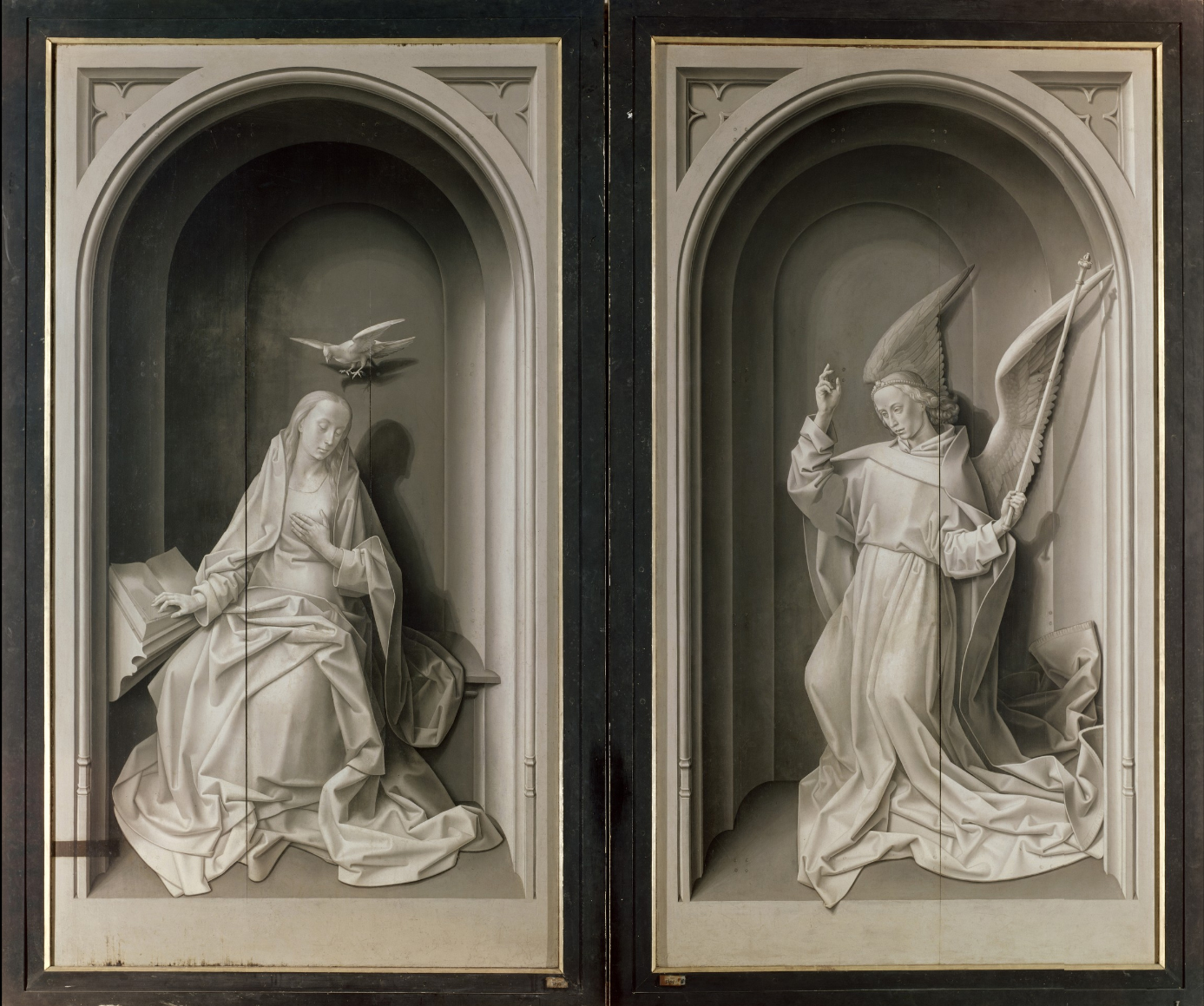
Hugo van der Goes, Portinari Altarpiece, closed, c. 1476, oil on wood, 274 x 652 cm when open (Uffizi)
Triptych altarpieces like the Portinari Altarpiece would have been kept closed, except on holidays and special feast days. Therefore, the exterior of the folding side wings of such artworks were typically painted. The Portinari Altarpiece’s exterior is decorated with a depiction of the Annunciation, the biblical event when the Angel Gabriel appeared to the Virgin Mary to tell her that she had been chosen to carry the son of God. This moment is understood in the Christian faith as the beginning of mankind’s salvation. Here, we see it essentially frozen in time, as the artist has chosen to paint these figures in grisaille. These faux sculptural figures are located in shallow architectural niches and reveal van der Goes’s incredible artistic talent in their believable naturalism.

Hugo van der Goes, Portinari Altarpiece, c. 1476, oil on wood, 274 x 652 cm when open (Uffizi)
Upon seeing the Portinari Altarpiece opened, one can imagine that any period viewer would have been stunned by the elaborate details and bright colors contained on the three panels within. In the center panel, we are privy to the quiet, magical moment just after Christ’s birth, the Nativity. Angels surround the kneeling Virgin Mary and newborn Christ child, and the three shepherds have rushed in from the countryside to bear witness to the miracle. This scene would have been instantly recognizable to any period viewer, and most would have noticed the iconographic details—certain objects and scenes that held multiple meanings.
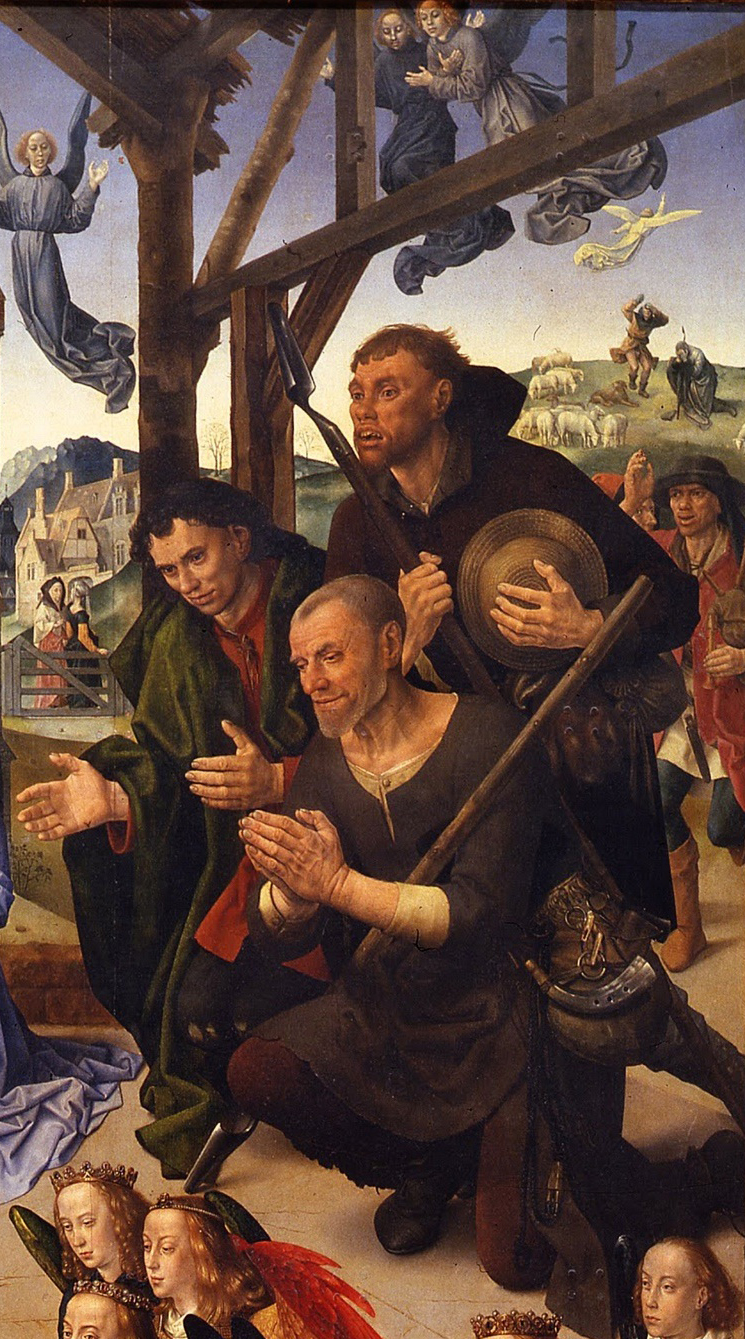
Hugo van der Goes, Portinari Altarpiece, detail of shepherds, c. 1476, oil on wood, 274 x 652 cm when open (Uffizi)
Far in the distance, behind the heads of the shepherds, we see those very same shepherds attending to their flock on the hillside. These tiny figures make gestures of surprise as an angel appears above them. This is the moment of the Annunciation of the Shepherds, when they were told that Christ had been born. In the repetition of these shepherds in the background and again in the foreground, the artist has used what is called continuous narrative, wherein figures are repeated within the same frame of an artwork to show more than one moment of a story.
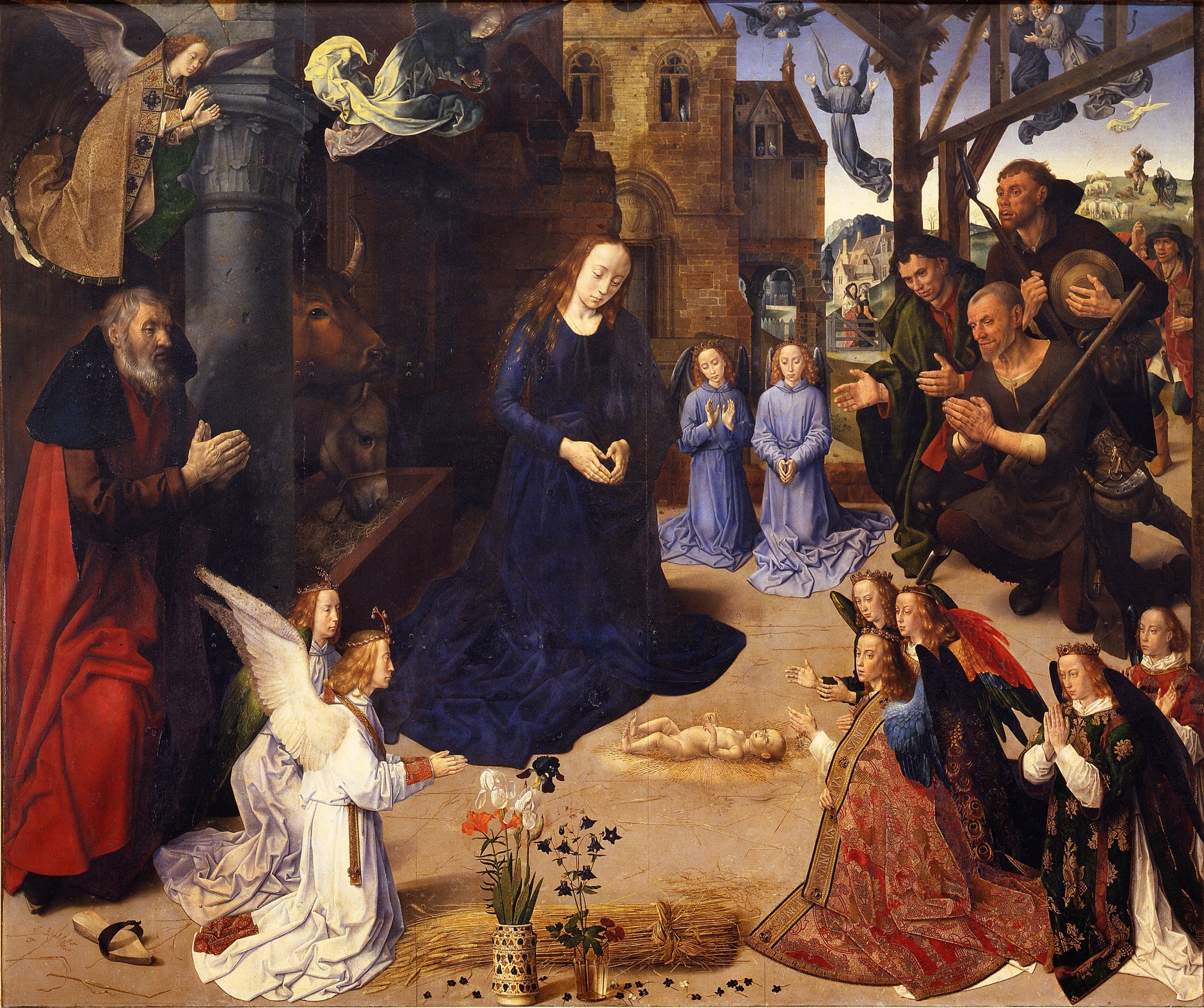
Hugo van der Goes, Portinari Altarpiece, center panel, c. 1476, oil on wood, 274 x 652 cm when open (Uffizi)
Moving to the left side of the central panel, we see Joseph, Mary’s husband, clothed in a rich red drapery. His hands are together in a gesture of prayer or supplication, as he honors the newly born Christ child. Just in front of him is a clog that has been removed. This detail symbolizes that this scene is taking place on holy ground. Above Joseph are two angels. Note that many angels in this work are dressed in elaborate liturgical, priestly garments (such as the one immediately above Joseph’s head and those on the right side of the image). This would have reminded viewers of the important sacrament that took place at the altar, in front of this altarpiece—the sacrament of communion (where the bread and wine miraculously transform into the body and blood of Christ). One angel, however, who hovers just above the ox and the ass (and is barely visible), has a somewhat dark, foreboding countenance. This is believed by some art historians to represent the lingering threat of Lucifer (Satan).
Everything centers around the Nativity
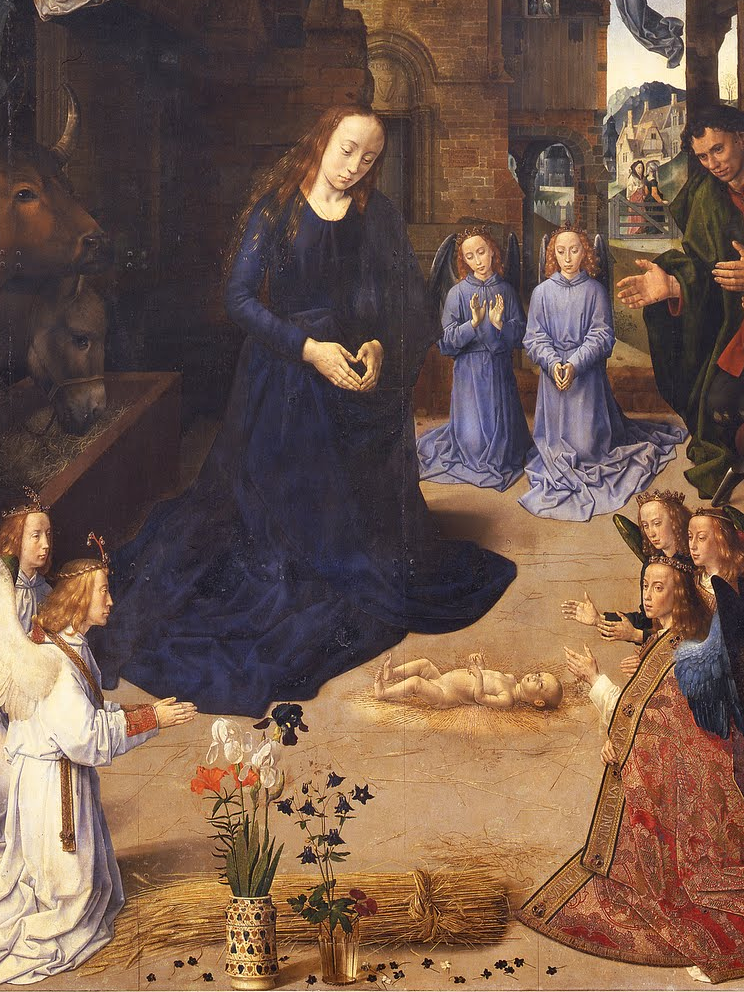
Hugo van der Goes, Portinari Altarpiece, detail of center panel, c. 1476, oil on wood, 274 x 652 cm when open (Uffizi)
In the center are the most important figures in the scene, the Virgin Mary and the infant Christ. It may seem strange that Christ is laying naked on the bare, hard ground, and that rays of light appear to emit directly from his body. However, this imagery is drawn from the writings of a medieval visionary named St. Bridget of Sweden. By the fifteenth century St. Bridget’s vision of the Nativity had become the inspiration for many depictions of this moment. Mary kneels beside Christ on the ground, a position meant to emphasize her humility, and bends over in somber adoration of her child. And her solemn nature, in this case, is meant to foretell what is to come—that she will have to sacrifice her son for the salvation of humanity.
Perhaps the most striking detail in the central panel is the group of objects in the foreground. Imagine this altarpiece in its original location, just above the altar of Sant’Egidio. The two vases would appear almost as though they were sitting on the altar itself. Notice, too, that the sheaf of wheat behind them is quite similar in color to and situated directly parallel with Christ’s body. At Mass, a priest would consecrate the Eucharist—the bread and wine—thereby turning it into the body and blood of Christ (according to Catholic tradition), which would be consumed in remembrance of his sacrifice. The hem of the red and gold brocaded vestment worn by the angel foregrounded on the right is embroidered with the repeated word “sanctus,” or holy, referencing the moment of the consecration of the Eucharist. The positioning of Christ’s body parallel to the sheaf of wheat, which in turn would be parallel to the physical bread on the altar, functioned as a stark reminder of what really took place at communion. The image masterfully creates a visual equation between the bread, the wheat, and Christ’s body.

Hugo van der Goes, Portinari Altarpiece, detail of center panel foreground, c. 1476, oil on wood, 274 x 652 cm when open (Uffizi)
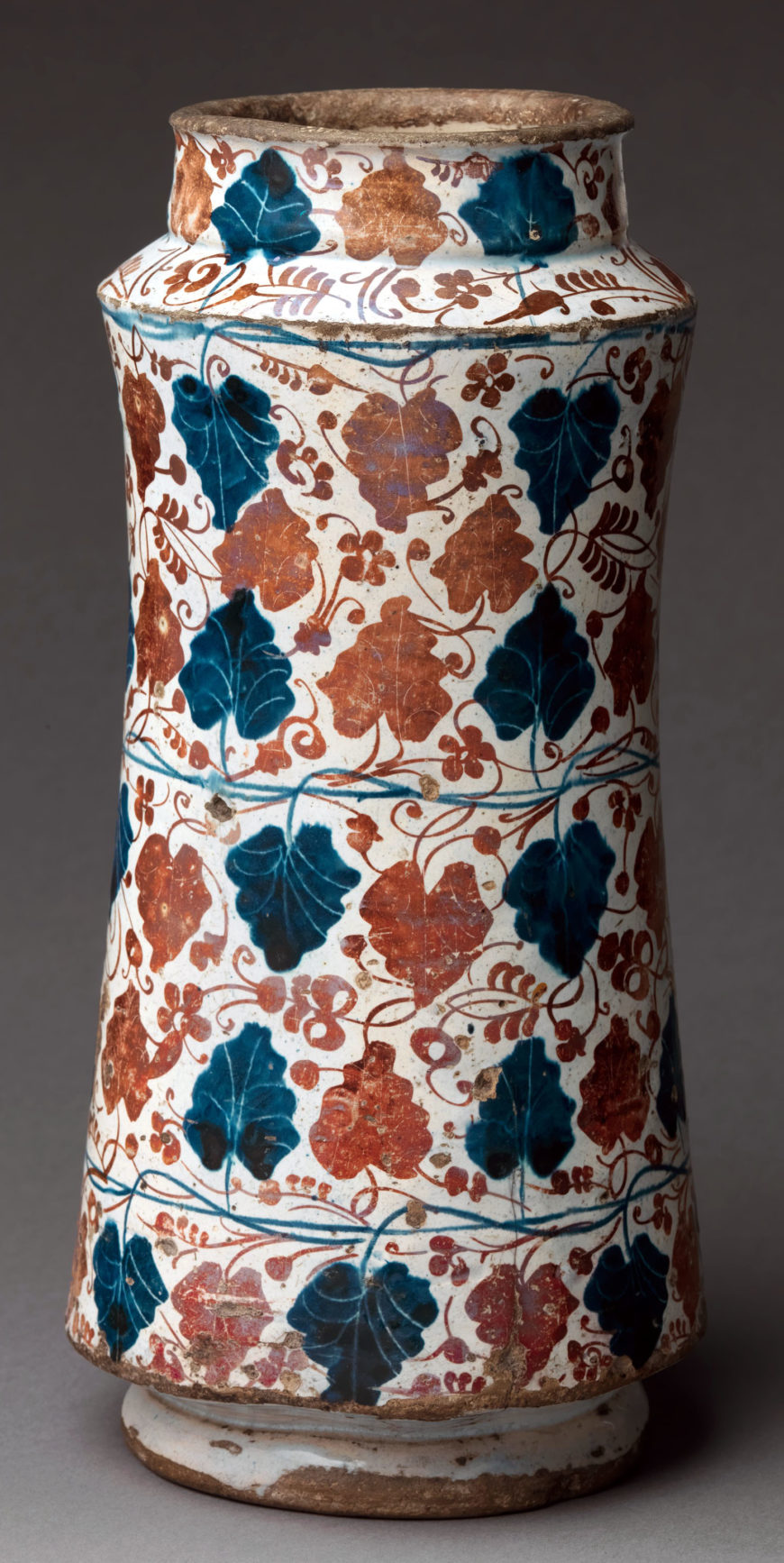
Pharmacy jar, 1435–75, tin-glazed earthenware, made in probably Manises, Valencia, Spain, 29.7 x 14.3 cm (The Metropolitan Museum of Art)
The vases and flowers just in front of the wheat are carefully studied depictions of recognizable flowers that each held symbolic meaning for period viewers. The Spanish albarello vase on the left is a type of vessel that traditionally held herbs and ointments used by apothecaries, an artistic choice which was almost certainly meant to comment on the altarpiece’s location in a hospital’s church. The albarello vase holds two white and one purple iris, along with a scarlet lily. These flowers represent the purity (white), royalty (purple), and Passion, or tortures, (red) of Christ. This vessel is also decorated with an ivy leaf motif that resembles a grape vine, alluding to wine, and therefore, to the blood of Christ, consumed with His body during Mass. The presence of this vase also reminds us that Valencia (in Spain), Italy, and northern Europe were engaged in extensive trade during this time, and expanding their trade across the globe. Spanish lusterware, like this vase, was a popular luxury trade item in the fifteenth century, admired for its reflective surface. The luster technique derives from Islamic pottery, and it is important to keep in mind that the Iberian Peninsula (Spain and Portugal) had a large Muslim population.
The clear vessel to the right holds three red carnations and seven blue columbines. The seven columbines are symbolic of the Seven Sorrows of Mary, while the three red carnations make reference to the three bloodied nails at Christ’s Crucifixion. As you can see, many of these flowers were meant to remind viewers of what was to come for Christ.
The story grows, and so does the Portinari family
Having discussed the details of the central panel, let’s take a look at the two side panels. In the backgrounds of each of the side panels, we find scenes that occurred before, after, and during the primary scene of the Nativity in the center. And just as the story is expanded in the side panels, we see that Tommaso and Maria have expanded their lineage, as well. Van der Goes, a master of detailed portraiture, depicted Tommaso Portinari in the left panel, kneeling in prayer as he faces the miraculous scene in the center. Because he paid for this elaborate gift, his family’s inclusion in the altarpiece essentially guarantees that they will forever be included in the daily prayers carried out in the church. Tommaso is accompanied by their two sons (as of the creation of this painting c. 1476), Antonio and Pigello, who kneel behind him. Note that, even if Tommaso were standing, he would still be noticeably smaller than the two figures who stand behind him. This is known as hierarchy of scale, where a visible difference in size between figures indicates that larger figures are of higher status. In this case, the larger figures are saints. St. Thomas, the name saint of Tommaso, works as his intercessor, effectively “introducing” him to the scene in the center and helping to convey his prayers to heaven. Behind St. Thomas is St. Anthony, the name saint of Antonio, as well as a “plague saint” who was frequently invoked by the sick, suffering, and dying. His presence makes yet another connection to the altarpiece’s original hospital location.
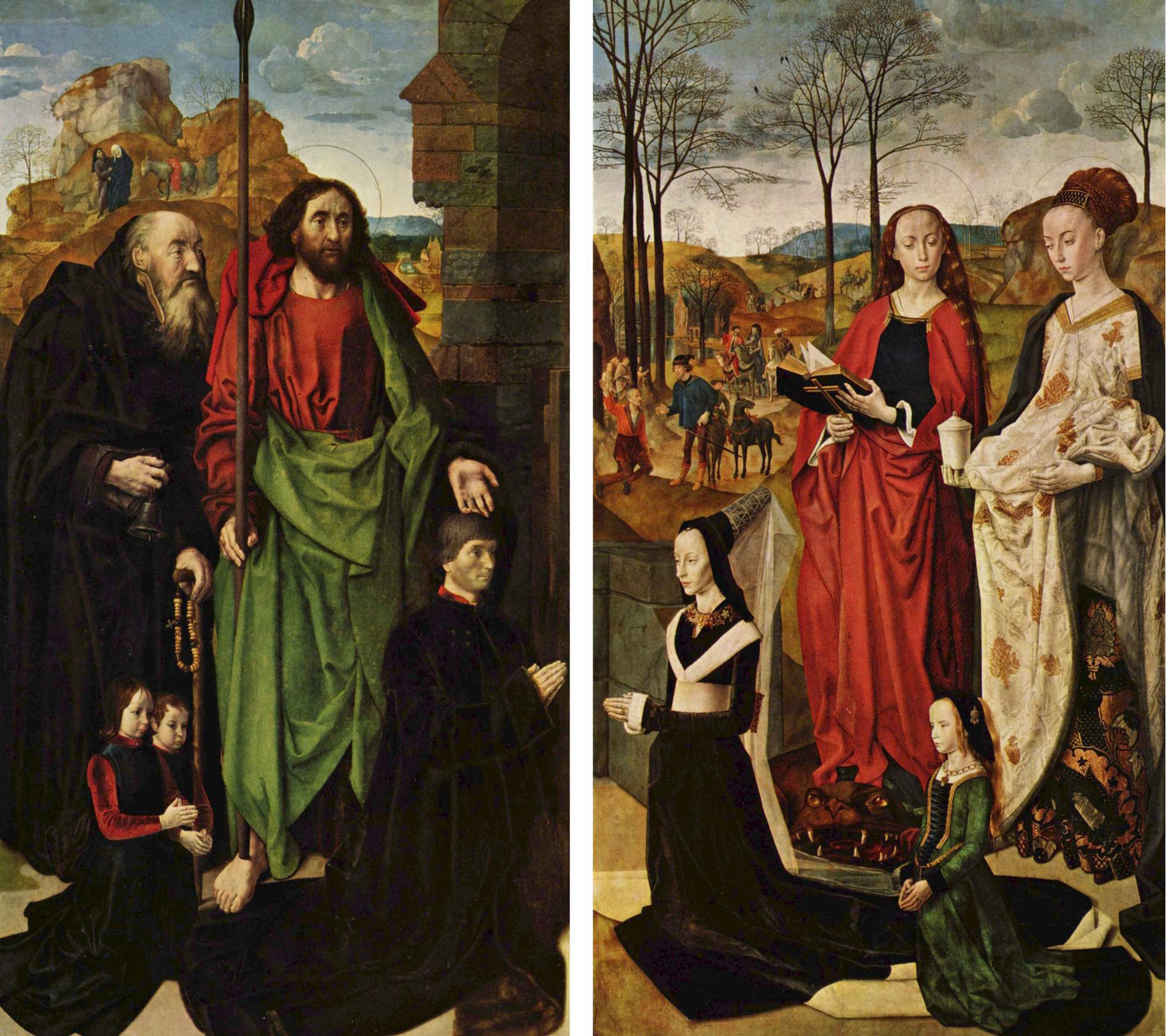
Hugo van der Goes, Portinari Altarpiece, side panels, c. 1476, oil on wood, 274 x 652 cm when open (Uffizi)
In the right panel, Maria Maddalena Baroncelli kneels in a position that mirrors her husband’s, accompanied by their daughter Margarita. These two figures are joined by their name saints, Mary Magdalene and St. Margaret. Interestingly, however, it is St. Margaret who stands behind Maria, not her name saint Mary Magdalene. St. Margaret is the patron saint of childbirth, and is evoked by pregnant women and those in labor in hopes of a successful process and outcome. St. Margaret is typically depicted as emerging from the mouth of or standing atop a dragon, as seen here (her legend explains that she survived being consumed by Satan, disguised as a dragon, whose stomach then rejected her and she emerged unharmed). As such, it is speculated that this may have been a deliberate choice, as Maria’s primary role as a wife in the fifteenth century was to bear children and continue the Portinari lineage, so she felt a stronger connection to St. Margaret at this point in her life.
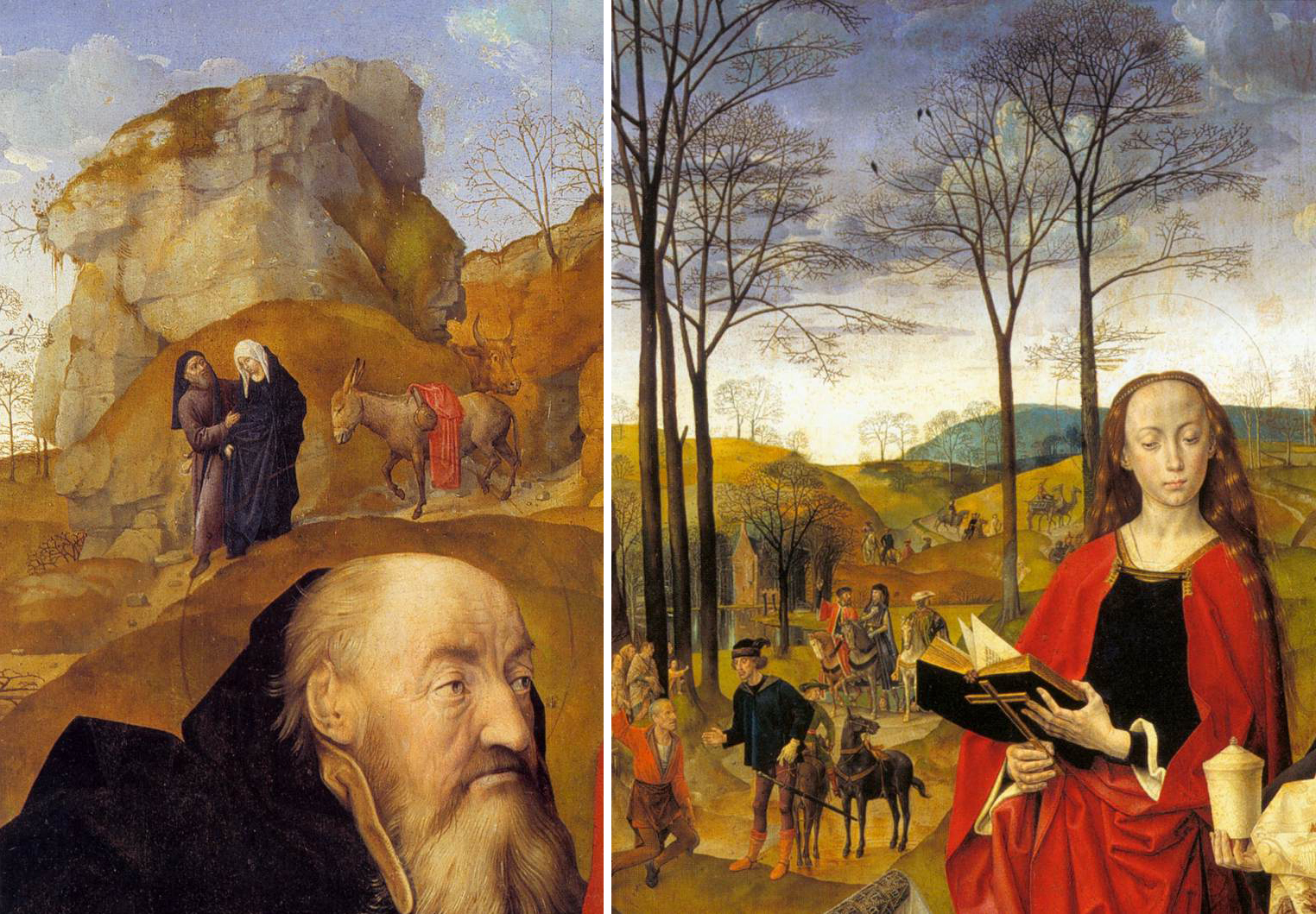
Hugo van der Goes, Portinari Altarpiece, details of the Holy Family and the Magi, c. 1476, oil on wood, 274 x 652 cm when open (Uffizi)
Just as in the central panel, the side panels also include small scenes in the background. In fact, the left panel continues the theme of childbirth already indicated by the Nativity in the center and the presence of St. Margaret in the right panel. Far in the distance behind St. Anthony’s head, we see Joseph attending to a pregnant Virgin Mary who has decided to walk rather than ride her donkey. This is a precursor to the miraculous birth that will soon occur, the Nativity. In the right panel, the landscape is populated by scenes of the three kings, the Magi, on their journey from far parts of the world to visit the newborn Christ.
What the northern painters did best
Hugo van der Goes’s Portinari Altarpiece encompasses the numerous aspects of northern renaissance painting that enthralled those in other parts of the world. This particular artwork perfectly embodies all the things that northern European painters were thought to do best—the rendering of complex landscapes that stretch far into the distance, skies that seem to capture light at different times of the day or under different circumstances, faces that appear highly individualized, even when they are not intended to be recognizable portraits, and carefully rendered, incredibly minute details throughout. Considering this triumph of artistic virtuosity, along with the work’s fascinating layers of symbolism, the direct and immediate impact of the Portinari Altarpiece on the art world of late-fifteenth-century Florence comes as no surprise. It is after this moment that we see, in particular, increased individualism in Italian faces and, perhaps even more importantly, a swift rise in the use of oil paint in Italian city-states.



